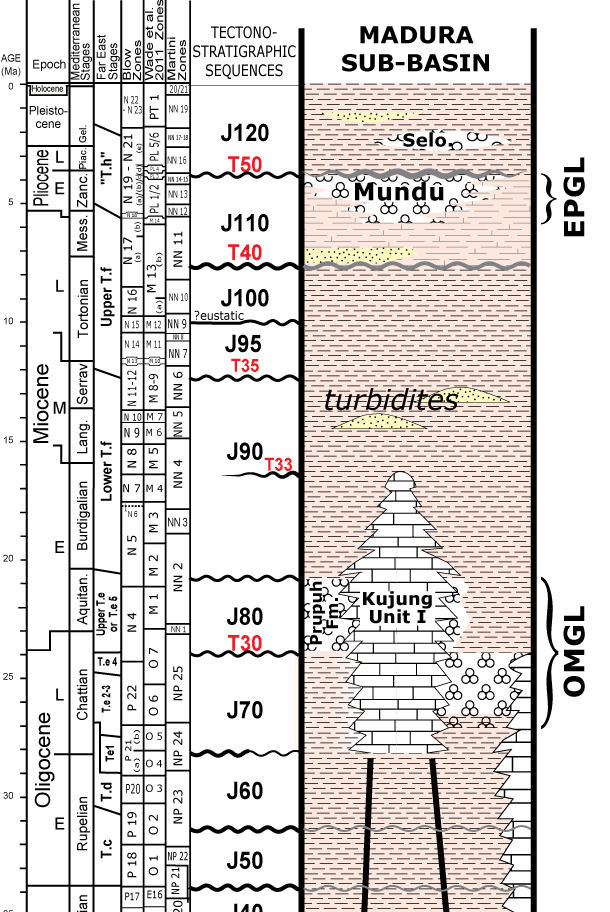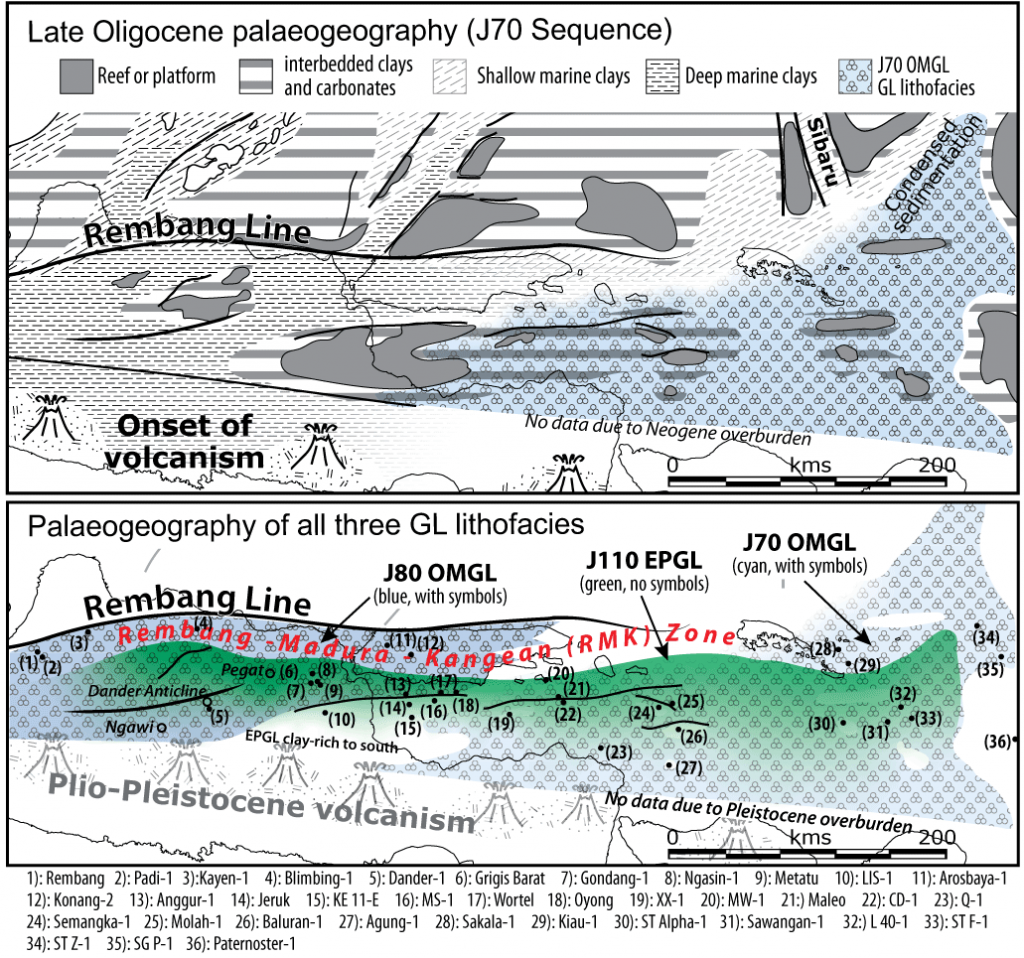Luan, X., Lunt, P., 2021. Occurrence in space and time of the Globigerina-sands of eastern Java; their stratigraphy, and controls on reservoir quality. Marine and Petroleum Geology
This paper is one of a set on eastern Java and the Makassar Straits:
- Lunt, P., 2019. The origin of the East Java Sea basins deduced from sequence stratigraphy. Marine and Petroleum Geology 105, 17-31
- Luan, X., Lunt, P., 2021. Eocene to Miocene stratigraphic controls in the far East Java Sea: Implications for stratigraphic studies. Marine Geology 436, 106479
- Luan, X., Lunt, P., 2021. Latest Eocene and Oligocene tectonic controls on carbonate deposition in eastern Java and the south Makassar Straits, Indonesia. Journal of Asian Earth Sciences,
- Luan, X., Lunt, P., 2021. Controls on Early Miocene carbonate and siliciclastic deposition in eastern Java and south Makassar Straits, Indonesia. Journal of Asian Earth Sciences,
As with the other papers this summary of the Globigerina-sands of eastern Java was liked by reviewers, with very few edits or changes requested, but the reviewers wanted more interpretation of the tectono-stratigraphic setting. As with the other papers in eastern Java a lot of space had to be dedicated to clarifying basic points of stratigraphy that had been lost or overlooked by previous workers. This dictated the emphasis and content of the paper, and reduced the space to discuss broader tectono-stratigraphy. The priority was to detail and justify new data to replace the claimed erroneous data, and only once this had passed peer review would it be wise to combine data from multiple papers to offer a new tectono-stratigraphy.
There are, in fact, 3 phases of GL facies in eastern Java; there is the commercial gas reservoir of the Early Pliocene GL facies (EPGL) and two parts to the Oligo-Miocene GL facies (OMGL).

The Early Pliocene GL (EPGL) facies has been cited as having two parts; the bulk in the Early Pliocene and a second part in a subsequent base Late Pliocene section (Triyana et al., 2007). Data was presented in the paper showing this division was an error in age dating. An event almost coinciding with the Early to Late Pliocene boundary (the T50 event of Triyana et al.) saw a major change in sediment supply and probably subsidence in some areas (and uplift in more distal areas, to supply the new sediments). This was highlighted by geohistory and age-depth plots, and the change was a large tectonic event, after which GL facies were extremely rare – only the small and localised latest Pliocene Selorejo Member onshore NE Java is known.
The division of the OMGL into two parts is new, as all prior workers had considered this distinct lithofacies as one “strata” called the Prupuh Formation (e.g. Matthews and Bransden, 1995). With a strong seismic reflector at it top and distinct gamma log response, this generally thin lithostratigraphic unit was considered a single marker bed. However, wells in the south and east had top Oligocene micro- and nannofossils coinciding with the top of the lithofacies, while the type Prupuh Formation and wells onshore NE Java have a GL lithofacies that was abruptly initiated by the top J70, Oligo-Miocene boundary event. This unusual correlation was noted in Lunt (2013, Figure 139) but more well data was required to confirm the existence of two GL lithofacies. The J70 Globigerina chalks in the south and east appear to be found around the Oligocene pinnacle reefs, far from the NW derived siliciclastics, and probably diluted by micrite from the Oligocene reefs. The major sequence boundary virtually coincident with the Oligo-Miocene Epoch boundary saw the Oligocene pinnacles rapidly subside and drown so the J70, latest Oligocene OMGL facies terminated and was followed by a hiatus. The complete sedimentary hiatus seems to be due to the loss of micrite derived from the reefs combined with the more modest subsidence of the shelf under the Java Sea. This led to the Kujung Unit I carbonate transgression (Batu Raja Formation in Central and West Java Sea), which cut off siliciclastic supply. As a result the more northeastern deep marine areas received only micrite from the Kujung / Batu Raja and Globigerina hemipelagics, while the southeastern areas had neither calcareous micrite or siliciclastic clays.
By including these corrections, plus supporting data, a very new stratigraphy was established, and that had to be the main topic of the paper. I am slowly building up to a new tectono-stratigraphy for Sundaland and this paper will be a data source, but I could only include that base minimum of regional geology and stratigraphy framework in the paper itself. The discussion of the paper and Figure 16 showed how each of the three GL lithofacies occupied a different geography as the basin was evolving.

The paper also includes a review of the use of planktonic foraminifera in environmental determination. This was partly covered in Luan and Lunt (2021: Latest Eocene and Oligocene tectonic controls on carbonate deposition) but is given in more detail here
First get the data in order and checked, peer-reviewed, pause for thought and then attempt what will be a very new integration. I was asked about mechanisms, and included a very interesting set of modern observations by Chen et al (2019). Not sure how such turbulence could be spotted and used predictively in the stratigraphic record, but it shows how little we know about our oceans.
References
Chen, H., Zhang, W., Xie, X., Ren, J., 2019. Sediment dynamics driven by contour currents and mesoscale eddies along continental slope: A case study of the northern South China Sea. Marine Geology 409, 48-66
Lunt, P., 2013. The sedimentary geology of Java. Jakarta: Indonesian Petroleum Association., 346 p.
Matthews, S.J., Bransden, P.J.E., 1995. Late Cretaceous and Cenozoic tectono-stratigraphic developments of the East Java Sea Basin, Indonesia. Marine and Petroleum Geology 12(5), 499-510
Triyana, Y., Harris, G.H., Basden, W.A., Tadiar, E., Sharp, N.C., 2007. The Maleo Field: an example of the Pliocene Globigerina bioclastic limestone play in the East Java Basin, Indonesia. Proceedings Indonesian Petroleum Association Convention 21, 17
Be First to Comment